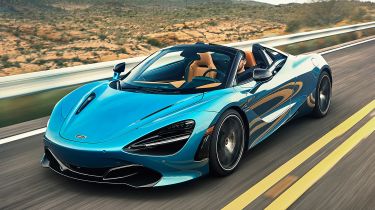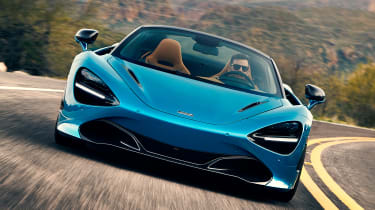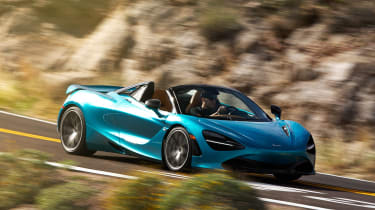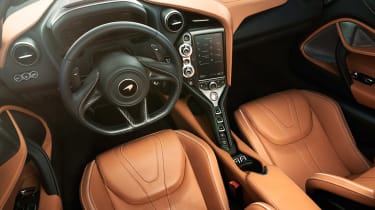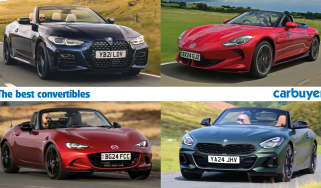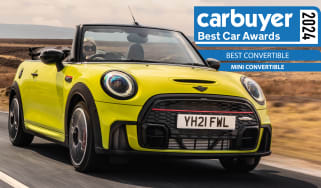McLaren 720S Spider convertible review
"Breathtaking performance combined with unadulterated engine noise makes the McLaren 720S Spider an even more visceral experience than the coupe"
Pros
- Incredible performance
- Open-air thrills
- Comfort setting
Cons
- Build quality issues
- Disappointing infotainment
- High price over coupe
The McLaren 720S is one of our favourite supercars because it has such a vast breadth of ability, as well as formidable outright performance. The 720S Spider, a convertible version, is arguably even better thanks to a folding hardtop putting you even closer to the action. Its performance figures are almost identical to those of the hard-top coupe, with the folding roof giving the added benefit of being able to hear the 710bhp V8 engine in all of its visceral glory.
If you’re in the market for a convertible supercar such as the McLaren 720S Spider, open-top rivals include the Ferrari 488 Spider, Lamborghini Huracan Spyder and the Audi R8 Spyder, even if the McLaren is the most expensive of all of these.
After the McLaren F1 supercar arrived in the 1990s, it’s hard to believe that the Woking-based firm only started producing road cars in 2011, with the introduction of the MP4-12C. Since then, the brand’s line-up has grown exponentially. McLaren splits its models into distinct categories depending on their performance and exclusivity. In the ‘entry-level’ Sports Series range are discontinued models like the the McLaren 540C, 570GT, 570S and the more hardcore 600LT (Long-Tail) model, plus Spider convertibles versions of the latter two.
More reviews
In-depth reviews
Above this, the 720S coupe, 720S Spider, 765LT and the Artura occupy the mid-tier Super Series, while the McLaren GT, which has a similar engine to this trio, is something of an outlier here, sitting under the brand’s Grand Tourer category. Beyond this, the Ultimate Series houses the upper echelon of the brand’s most exclusive and fastest models, including the Elva, Senna, Senna GTR and the Speedtail.
The McLaren 720S Spider adds to the beautiful bodywork of the coupe with glazed buttresses and a removable roof. Underneath, there’s the same carbon-fibre core as the coupe, which doesn’t need any extra strengthening to keep it rigid. That means the exhilarating speed and power remains the same. The sprint from 0-62mph is dispatched in just 2.9 seconds (0.1 seconds slower than the coupe), and the car will go on to a top speed of 212mph.
McLaren has tweaked the ‘dihedral’ doors for the convertible, but the result is that our test car had different-sized panel gaps on each side. It’s one of the only bugbears of a car that is otherwise nearing supercar perfection.
MPG, running costs & CO2
If you’re contemplating buying a car of this type, it’s unlikely you’ll be worried about fuel economy and CO2 figures. Compared to a normal car, the running costs are eye-watering, but figures of 23.2mpg and 276g/km of CO2 are broadly similar to the Ferrari 488 GTB and Lamborghini Huracan. However, while the Huracan is claimed to return the same economy figure as the 720S, the Lamborghini has 100bhp less, and can’t match the McLaren’s performance figures.
The price increase for the 720S Spider over the coupe is significant. Starting at nearly £240,000, the Spider is nearly £30,000 more expensive than the fixed-roof model, but we’ve no doubt that McLaren will find plenty of buyers regardless. Of course, you can significantly add to the price by choosing a few optional extras - our test car had a special roof worth £7,500.
Engines, drive & performance
With a twin-turbocharged 4.0-litre V8 producing 710bhp and a formidable 770Nm of torque, the performance offered by the McLaren 720S Spider is rarely anything other than breathtaking. Find somewhere legal to use launch control, and the force of acceleration will have you firmly pinned back in your seat. The performance is frankly brutal, and it’s amplified by the extra engine noise in the Spider. A Ferrari 488 GTB sounds better but we don’t think the difference is a decisive factor in its favour.
More impressive than the 720S’s straight-line speed is the way it corners. It’s incredibly poised, accurate and develops huge amounts of grip, with the lightweight core ensuring that it’s both agile and incredibly stiff on the road. During our test, we were given a chance to test the brutal acceleration of the 720S Spider on a track, where it remained very composed with only minor steering and throttle adjustments being required to keep the car straight while spinning the rear wheels up to fifth gear. Equally impressive are the huge carbon-ceramic brakes, which work with the car’s active aerodynamics to provide huge amounts of stopping power, even at triple-digit speeds on a track.
You can dial up the car’s responses by switching through the driving modes. For ultimate driving thrills, the Track mode is the most focused – it even hides the infotainment screen so you can concentrate on driving. Below that are Sport and Comfort, which manage to make the 720S Spider both insanely fast yet more comfortable at normal motorway speeds, too.
Interior & comfort
As you’d expect, the interior has been carried over wholesale from the coupe, albeit with a couple of tweaks. The Bowers & Wilkins stereo, for example, has been changed to specifically complement top-down driving, even if the wind noise and buffering isn’t too intrusive. When you want to put the roof up, it takes just 11 seconds at up to 31mph.
The ride quality is very impressive for a car that’s so focused on performance, with the suspension capable of cushioning you from road imperfections at normal speeds. All-round visibility is surprisingly good as well, despite the low-slung driving position. It’s clear that McLaren has worked very hard to make the 720S usable but the interior isn’t perfect. The infotainment system is a let-down: it’s hard to use, can be slow to react and the connectivity is not very user friendly to set up.
Practicality & boot space
Practicality is unlikely to be one of your biggest concerns when splurging nearly £250,000 on a supercar, but the 720S Spider does fairly well in this department compared with rivals. We mentioned it briefly above, but it’s refreshing to drive a supercar that doesn’t ignore the importance of visibility. You don’t want to be scraping those carbon-fibre parts on a kerb.
Under the bonnet there’s 150 litres of usable space, which is only slightly less than the boot space of a Toyota Aygo. You’ll be able to fit a couple of bags in there, or stock up on groceries in a midweek shop. With the roof up, there’s another 58 litres of space to fill.
Reliability & safety
Because the 720S Spider will be sold in such small numbers, it won’t be crash-tested by Euro NCAP. However, it should keep occupants safe in a collision. The car’s Monocage II-S carbon-fibre chassis essentially cocoons the driver and passenger in a rigid capsule, and its construction means it’s incredibly strong. It was designed for track use and the possibility of high-speed impacts.
Some previous McLarens have suffered with the odd electrical gremlin but generally the company is known for its painstaking attention to detail, so we’d expect owners to face few problems.

